A belated review of the exhibition Jeremy Deller – Joy in People…
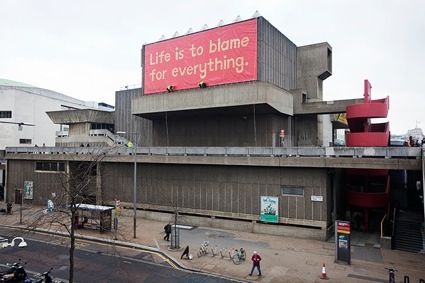 Life Is to Blame for Everything, banner by Jeremy Deller, outside the Hayward Gallery in London. Photograph: David Levene
Life Is to Blame for Everything, banner by Jeremy Deller, outside the Hayward Gallery in London. Photograph: David Levene
It’s always daunting to write about an exhibition that so many articles have commented on already. We’ve all read that Jeremy Deller won the Turner Prize in 2004. That he has never been a good drawer nor a talented painter. In fact, his teacher strongly advised against art school (a suggestion i fully understand if Deller is to blame for the mural painted behind the screen that shows the documentary So Many Ways to Hurt You, the Life and Times of Adrian Street, see photo below.)
Jeremy Deller does art outside galleries. It thrives in ‘low culture’ and it is usually ambitious, socially-engaged and unexpected. Indeed, most of his career is built on looking for art in the most unpredictable places, working with the public or with people who have particular knowledge or skill but who wouldn’t otherwise be associated with the contemporary art world. They include unemployed miners, brass bands, a campaign banner maker, fans of Depeche Mode, a glam rock wrestler, experts in battle re-enactments, etc. He even collaborated on an art project with nightclub owner and trendsetter Peter Stringfellow.
In late February, a retrospective of Jeremy Deller’s work opened at the Hayward gallery. It is called Joy in People and joy is precisely what it brings.
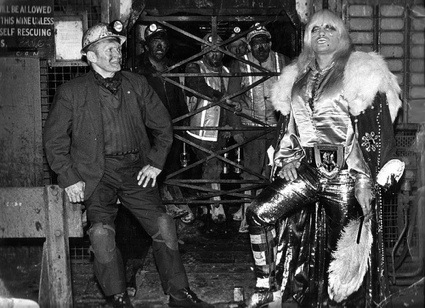 Exotic Adrian Street and his father, 1973. Photo : Dennis Hutchinson
Exotic Adrian Street and his father, 1973. Photo : Dennis Hutchinson
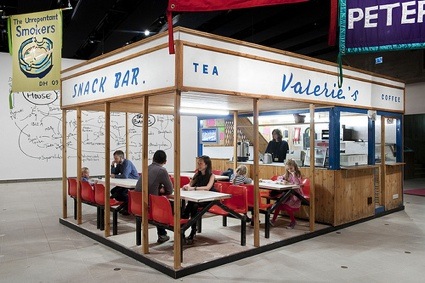 Jeremy Deller, Valerie’s Snack Bar, 2009. Photo Linda Nylind
Jeremy Deller, Valerie’s Snack Bar, 2009. Photo Linda Nylind
It should be tricky to exhibit the work of Jeremy Deller, an artist who doesn’t produce artefacts but experiences, happenings and interventions. Out there. In the streets. Neither you nor i were there. Consequently, the show includes many videos and video documentation of some of his works. But there’s also a reconstruction of Valerie’s snack bar in Bury market, Lancashire. You can sit down and get a free cup of tea. There are people hired to read texts to make you melancholic, people on hand to discuss their experience of war in Iraq, t-shirts, photos of his ‘failed’ artworks, an introduction the world of re-enactment aficionados, music videos, magazines, a replica of Deller’s teenage bedroom where he organized a solo show while his parents were on holiday, etc. Many art critics wrote that it was all a bit ‘second hand’. But if it was, it was good enough for me. I spent a whole afternoon visiting Joy in People. I’ll probably go back before the show closes.
Most of the works on show are very well documented already but i’m going to highlight two that i found most irresistible.
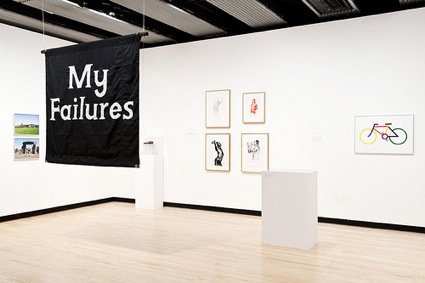
The show had a whole section, titled My Failures, that documents the projects Deller never realized.
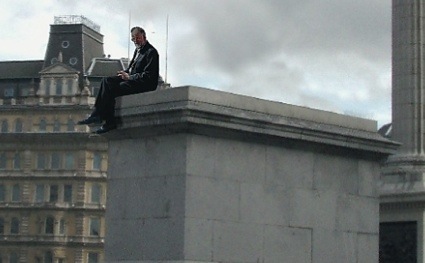 Jeremy Deller, Fourth Plinth proposal – ©Jeremy Deller
Jeremy Deller, Fourth Plinth proposal – ©Jeremy Deller
One of them is a proposal for Trafalgar Square’s Fourth Plinth. Deller wanted to place on top of the plinth a life-size model of Dr David Kelly, the biological warfare expert who committed suicide in 2003 following the media frenzy provoked by his comments on the British government’s dossier on weapons of mass destruction in Iraq.
‘I had two ideas for the Fourth Plinth that I suggested to the committee, the first was for a destroyed car from Baghdad – a victim of the Iraq occupation – called “Spoils of War (Memorial for an Unknown Civilian)”. The other was going to be a mannequin of Dr David Kelly [who committed suicide in 2003 following the controversy his comments on the British government’s dossier on weapons of mass destruction in Iraq] just sitting on the edge of the plinth, facing Whitehall, because some people may have forgotten who he was. They were both ways of deflating the meaning or effect of public sculpture, basically to act as an antidote to the sculpted men who had done things in battle.’
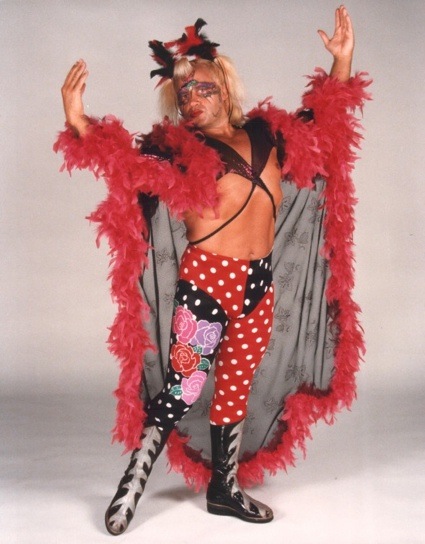
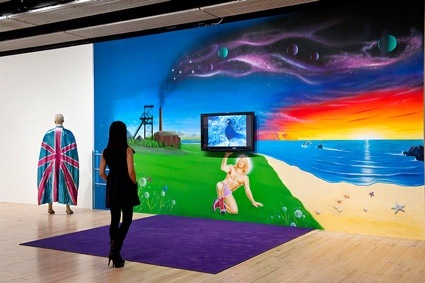 So Many Ways to Hurt You (The Life and Times of Adrian Street), 2010. Photograph: Linda Nylind
So Many Ways to Hurt You (The Life and Times of Adrian Street), 2010. Photograph: Linda Nylind
I wish So Many Ways to Hurt You, the Life and Times of Adrian Street was available online somewhere (there’s only a short extract of the film.) So Many Ways to Hurt You documents the life of glam rock wrestler Adrian Street Street was born into a coal mining family in Wales in 1940. He was sent down the mine at a very young age, fled to London at 16 to pursue a career as a model for bodybuilding magazines and professional wrestler. One day he realized that the way to stardom was through a glam rock persona that would tap into the homophobia of the macho wrestling world. And so he started designing and cutting his own costumes, wearing garish make-up and extravagant platinum hair-dos. He’d blow kisses to his opponents or make silly dances to further provoke them.
Street now lives in Florida, he’s still wrestling but I haven’t got a clue about what happened to his singing career:
Also in the exhibition:
His 2001 film The Battle of Orgreave reconstructed the famous and violent clash between police and striking miners in 1984 with the help of historical re-enactment societies and former miners.
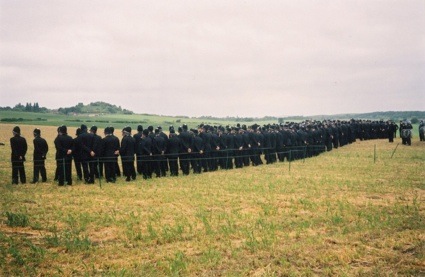 Jeremy Deller, The Battle of Orgreave, 2001
Jeremy Deller, The Battle of Orgreave, 2001
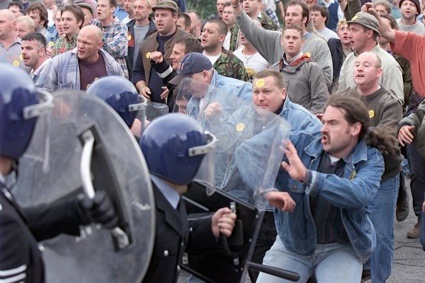 Jeremy Deller, The Battle of Orgreave, 2001
Jeremy Deller, The Battle of Orgreave, 2001
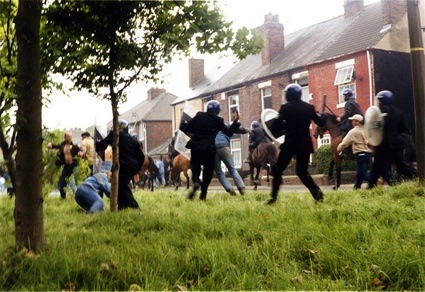
For 1997’s Acid Brass, Deller invited a brass band to play acid house tunes. The video at the Hayward shows the actual performance but just the soundtrack makes my day.
The History of the World demonstrates the intertwined histories of traditional brass band music and the acid house scene of the late 1980s.
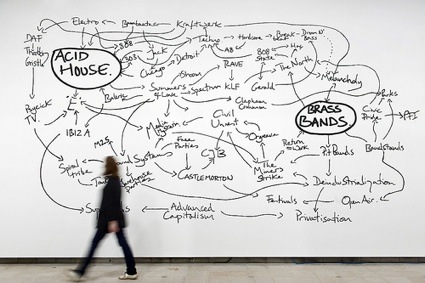 The History of the World, 1997. Photo Linda Nylind
The History of the World, 1997. Photo Linda Nylind
It Is What It Is or how to get people to sit and discuss about the war in Iraq using a car wreck.
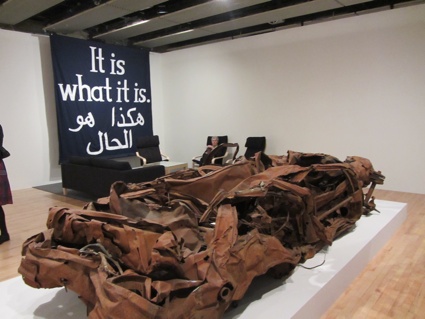 Jeremy Deller, It Is What It Is, 2009 (detail)
Jeremy Deller, It Is What It Is, 2009 (detail)
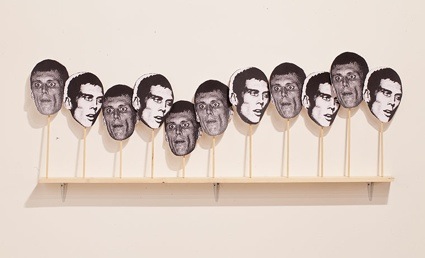 Jeremy Deller, The Search for Bez, 1994. Photograph: David Levene
Jeremy Deller, The Search for Bez, 1994. Photograph: David Levene
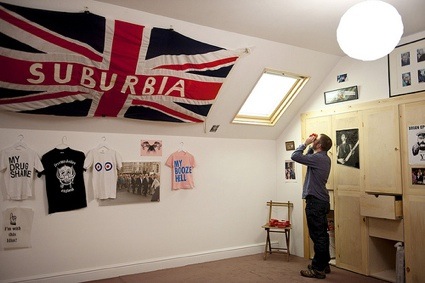 Jeremy Deller, Open Bedroom, 1993. Recreation for Joy in People. Photo LInda Nylind
Jeremy Deller, Open Bedroom, 1993. Recreation for Joy in People. Photo LInda Nylind
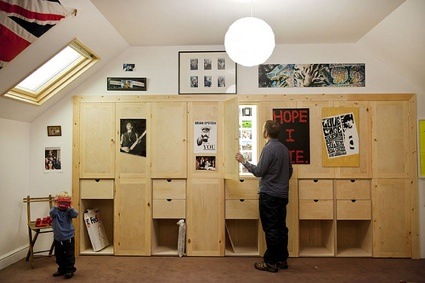 Jeremy Deller, Open Bedroom, 1993. Recreation for Joy in People. Photo LInda Nylind
Jeremy Deller, Open Bedroom, 1993. Recreation for Joy in People. Photo LInda Nylind
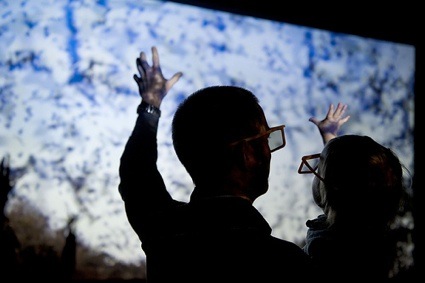 Jeremy Deller, Exodus, 2012. Photo Linda Nylind
Jeremy Deller, Exodus, 2012. Photo Linda Nylind
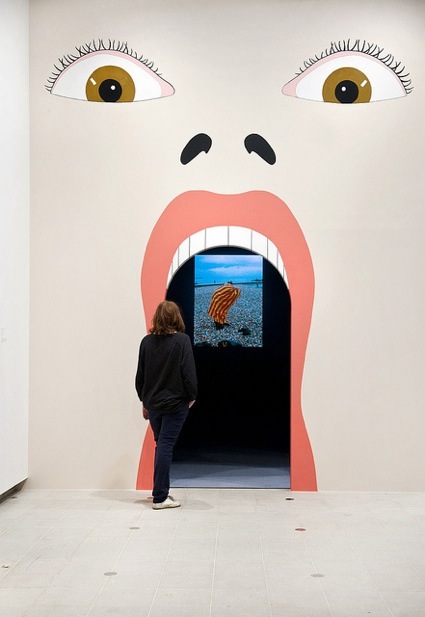 Mural by Stuart Hughes in Jeremy Deller Joy in People. Photo by Linda Nylind
Mural by Stuart Hughes in Jeremy Deller Joy in People. Photo by Linda Nylind
Don’t miss The Posters Came from the Walls, a brilliant, witty and charming film about fans of Depeche Mode around the world. It’s in the gallery upstairs, by the entrance. And it’s free.
Jeremy Deller – Joy in People remains open until 13 May 2012 at the Hayward Gallery in London.
More in the I Love Jeremy Deller series: Adrian Street, Queen Bitch of pro wrestling, Baghdad, 5 March 2007, Ed Hall, the art of protest banners and The Steam Powered Internet Machine.
